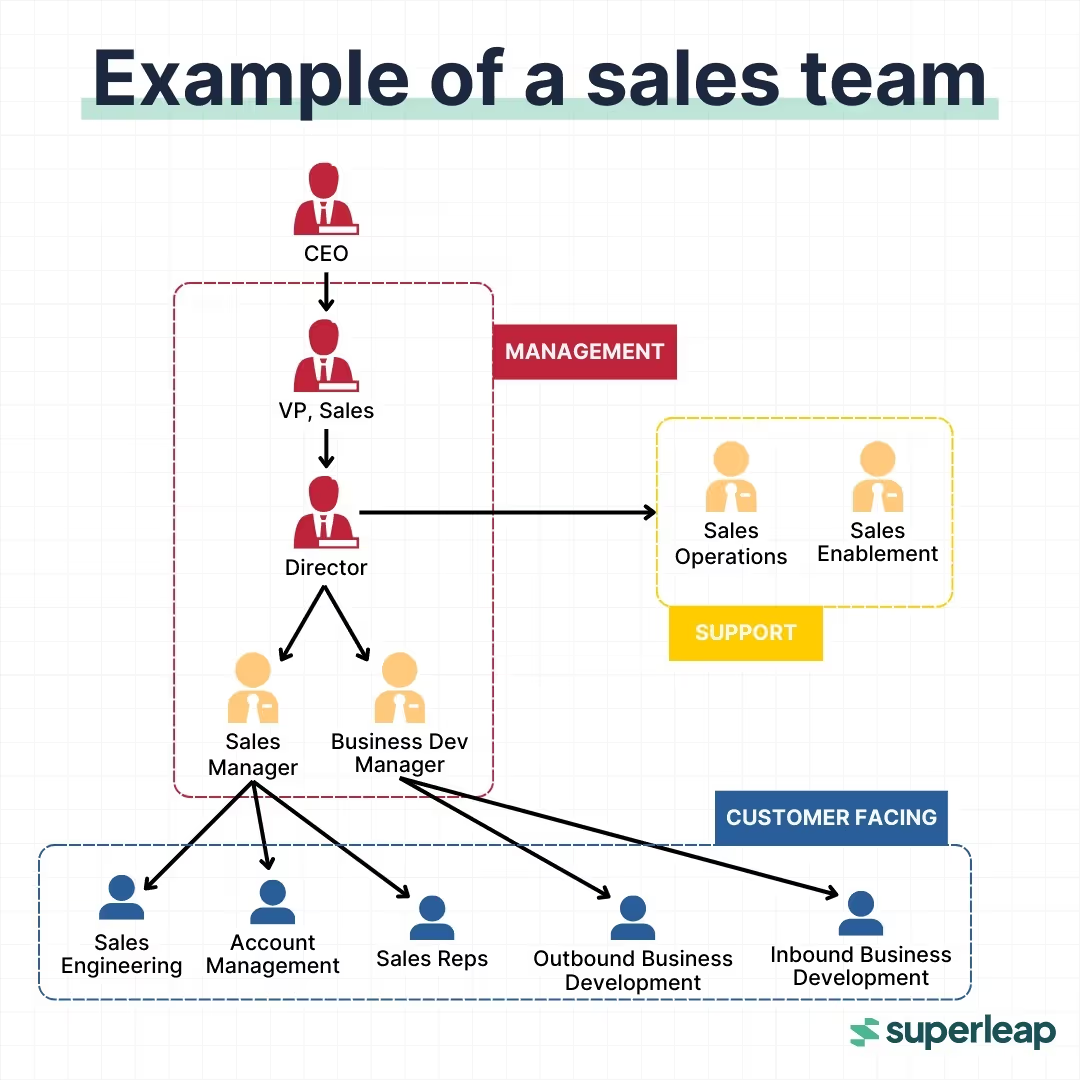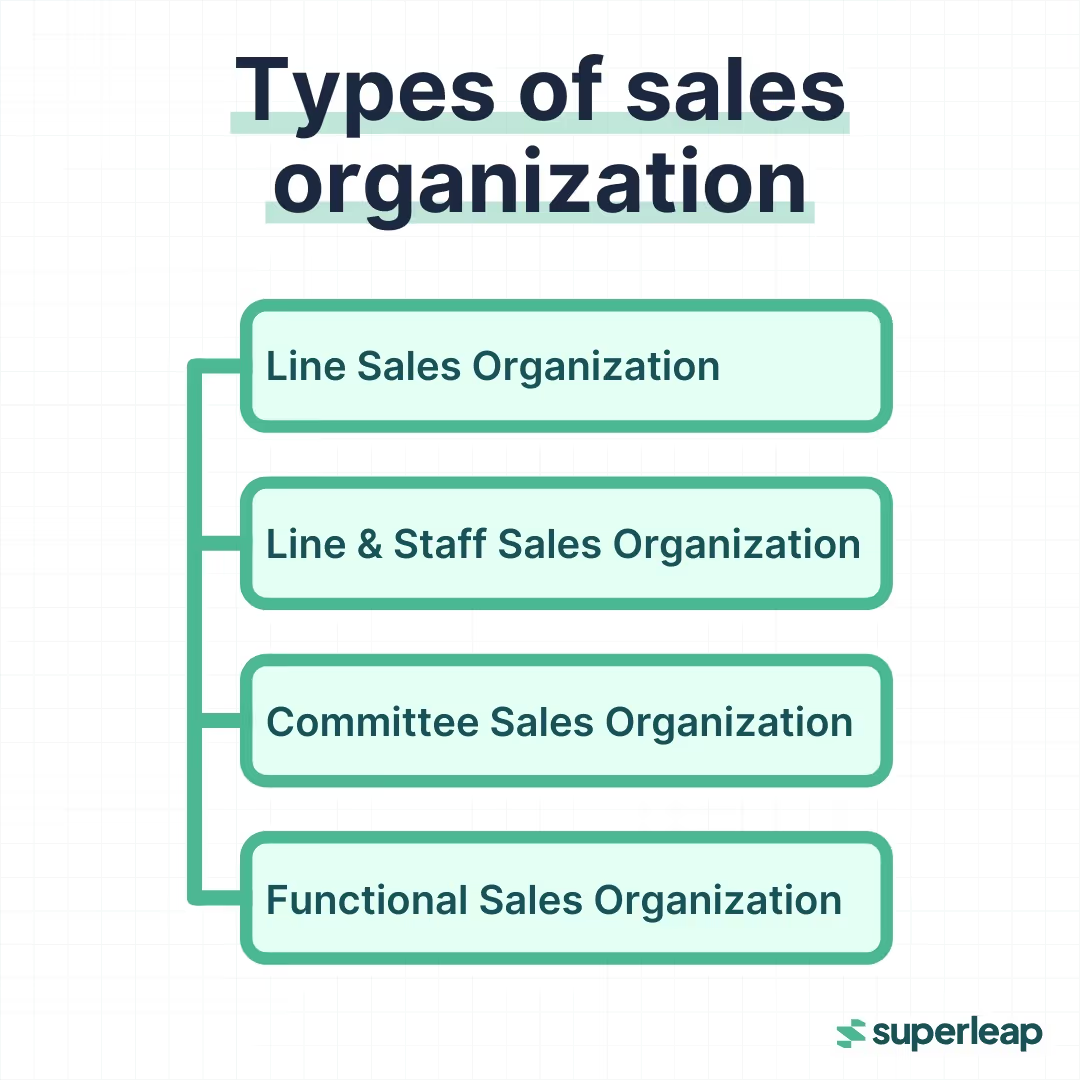

No matter who you are, you’d know that there is often a structure to everything successful.
If you know a bit about the world, you’d also know that there’s a reason apples fall down and gravity exists. There’s a strong structure on which tall, stable buildings are built. Similarly, there is a structure to the sales process. And, the sales organization of a company ensures that this structure is well maintained.
To be successful in the field of sales, you need to have a sales organization. And, you’ll also need to make an informed choice as to which sales organisation structure works best for your sales team.
Let’s read and understand sales organizations and their structures in detail.
What is a sales organization?
A successful sales organization is one where the functions of each department are carefully planned and coordinated and the efforts of the individuals supervised.
A sales organization is extremely beneficial for a variety of reasons. A well-structured sales organisation ensures that the line of authority is well defined, sales teams are motivated, and there is coordination and balance.

Why is sales organization important?
As long as the business is small, there is no need for a sales organisation because the owner can sell all of the product personally, or in some situations, he has one or two salespeople working for him directly. However, the need for a sales organisation becomes apparent as the company or business itself grows due to factors like market expansion, large-scale production, competitive markets, etc.
Here are some of the reasons why sales organisation is essential in a company:
- To define line of authority: It is important to define and identify the flow of authority, indicate where responsibility lies, and specify who is to be held accountable to whom.
- To determine span of control: It is very important to enforce proper supervision of the sales force and a well defined sales organisation helps make that easier.
- To define decision making process: Sales organisation also aids in determining who can make decisions regarding sales and client accounts.
- To assign specialties: The sales organisation defines the activities and specialities for entry-level, middle-level, and top-level positions.
- To motivate employees: Since the career path is well known to all the employees, they try to work hard and with dedication to reach higher levels according to the organization’s structure.
- To achieve coordination and balance: By explicitly identifying formal relations between various positions in the sales department, the sales organisation avoids uncertainty about an individual's function and responsibility within the organisation.
- To reduce the need for executive time: A sound organisational design enables the effective use of specialisation, allowing executives to spend less time on operations and more on planning.
What are the principles behind a sales organization?
1. Degree of specialization:
In terms of specialisation, salespeople's responsibilities range from generalised to specialised. An absolute generalist would be required to participate in all forms of sales activities for all of the company's products and to sell to all of the company's clients.
On the other hand, an absolute specialist would have a considerably more rigid focus and would be restricted to a limited set of selling activities for only a portion of the company's products, as well as selling exclusively to a specific group of clients.
2. Degree of centralization:
Organizational centralization is the deliberate and consistent allocation of authority to a few people. Under centralisation, senior management makes crucial decisions and subordinates follow them.
3. Span of control:
It refers to the quantity of subordinates managed by each manager. Each manager is typically assigned one to ten individuals. A range of circumstances determine the ideal span of control at a certain level in the organisational hierarchy.
4. Unity of objectives:
This idea holds that an organization should have unity of goals. A company might have several sales sub-organizations depending on the product and selling strategy. Every sales suborganization has a set of objectives it aims to meet for the company.The goals of every sales sub-organization should directly relate to the main goal of the company.
5. Coordination:
In an organization, the sales organization structure should offer a framework that facilitates its seamless integration with other departments. This guarantees that the buyer will receive the goods or services on time.
6. Equivalence of authority and responsibility:
This principle states that if an employee is assigned a set of responsibilities, he/she must be given the required level of authority to perform those tasks.
7. Flexibility:
According to this principle, a variety of internal and external factors may have an impact on how an organisation operates. Therefore, the structure of the sales organisation should be adaptable enough to accommodate any future adjustments that may be necessary.
What are the types of sales organisations?

Line sales organisation
A line sales organisation is one of the most basic kinds of sales organisation where each member is held accountable for their actions and decisions.
It is widely used by smaller businesses and those with a small number of salespeople. This structure is commonly utilised in businesses that operate within a specific geographic area or specialise in a single product line. In a line organisation, the chain of command runs from top-level sales executives to their subordinates.
In organisations, leaders have line authority, which means that subordinates report to one person at the next higher level. This establishes a clear line of accountability, where decision-making and action take place.
Line and staff organization
This structure combines the benefits of line sales and specialized staff to support and advise.
Line and staff sales departments are popular in large and medium-sized businesses. It employs a huge number of salespeople and sells a diverse range of items over a wide geographic area. Unlike the line organisation, the line and staff organisation gives the top sales executive access to a team of professionals.
These professionals specialise in dealer and distributor relations, sales analysis, planning, promotion, training, service, warehousing, and other related areas.
Functional sales organisation
A functional sales organization focuses on dividing the team based on their area of expertise.
Within this framework, individuals, including executives and salespeople, are assigned specific tasks.
This sales organisational structure is intended to maximise the performance of executives and salespeople by distributing tasks based on their unique capabilities. However, conflicts can occur when effective coordination fails.
Committee sales organisation
This sales organisation structure is free of strict rules, but in order to improve the firm's performance and sales process, a committee of sales executives, sales teams, or a combination of both is formed.
How to choose the most effective sales organisational structure?
1. Company size
When deciding on a sales organisation structure, keep your company's size in mind.
Smaller companies tend to benefit from flexible arrangements where roles overlap, and communication flows easily.
Meanwhile, larger organisations typically require more complicated structures with well-defined responsibilities to manage large-scale activities and ensure proper coordination across multiple teams and regions.
2. Industry
Different industries have varied requirements, thus the industry in which a company works can influence the most effective sales organisational structure.
B2B organisations, for example, require frameworks that enable longer sales cycles and relationship management, whereas B2C companies are more likely to prioritise volume and speed of transactions.
IT organisations may normally turn towards product-based structures to better handle rapid innovation and product changes, whereas retail typically favours regional or functional structures to enter local markets and run efficiently.
3. Sales strategy
A company's sales strategy, whether it’s growth-focused, customer-centric, or stability-oriented, has a significant impact on its organisational structure.
There are different types of sales strategies, such as:
- Growth-focused: This strategy focuses on rapid expansion and increased market share. Sales structures are typically dynamic and scale quickly to adjust to new markets and opportunities.
- Customer-centric: This approach emphasises providing excellent customer experiences and developing long-term partnerships. It is typically segregated by client type or need in order to provide personalised interaction and enhanced customer satisfaction.
- Stability-oriented: This strategy focuses on generating a consistent stream of money while minimising risks. Sales structures that employ this method are often well-established with clear procedures and roles.
What are the challenges in managing sales organisational structures?
1. Alignment issues
Ensuring that sales strategies and targets are aligned with broader company objectives can be difficult.
Different teams may have competing agendas, therefore resolving disagreements between departments is another significant challenge. Interdepartmental conflicts should be resolved swiftly and politely, as delaying them can lead to friction and hinder alignment efforts.
2. Communication issues/gaps
Different organisational structures can sometimes result in communication gaps, preventing teams from exchanging critical information. This could have a substantial impact on sales performance.
To boost communication, the company must establish regular check-ins and use communication technologies effectively. Developing clear communication protocols might help businesses to close such gaps.
How did sales organizations evolve?
The evolution of sales organizations reflects the changes in business practices, technology, market dynamics, and customer expectations over time. As companies adapt to these shifts, sales organizations have transformed to become more efficient, customer-centric, and technology-driven.

1. Traditional Sales Organization (Pre-20th Century)
Characteristics:
- Sales was highly transactional with limited focus on relationships.
- Salespeople operated independently, often traveling door-to-door or relying on marketplaces to sell goods.
- No formal structure or dedicated sales teams existed; business owners handled sales.
- Success was primarily based on individual charisma, negotiation skills, and product knowledge.

2. Industrial Era Sales Organization (Early to Mid-20th Century)
Characteristics:
- The rise of mass production and distribution created the need for structured sales organizations.
- Companies established regional sales teams to handle growing markets.
- Focus shifted to territory-based selling, where sales reps were assigned specific geographic areas.
- Emergence of sales managers to oversee teams and ensure alignment with organizational goals.
- Introduction of incentive-based compensation such as commissions to motivate salespeople.

3. Marketing Integration Era (Mid to Late 20th Century)
Characteristics:
- Sales and marketing functions began to align to improve customer acquisition.
- Companies adopted sales training programs to standardize skills and methodologies.
- Building long-term connections with customers rather than focusing solely on one-time transactions.
- Use of customer segmentation to target specific markets and tailor sales pitches.
- Adoption of telemarketing as an inside sales strategy to supplement field sales.

4. Technology-Driven Sales Organization (1980s to 2000s)
Characteristics:
- The introduction of Customer Relationship Management (CRM) systems revolutionized sales tracking and relationship management.
- Companies began leveraging data to inform sales strategies and improve decision making.
- Shift to consultative selling, where salespeople act as advisors, focusing on solving customer problems.
- Sales structures became more specialized, with roles like business development representatives (BDRs) and account executives (AEs).
- Adoption of email and digital communication tools streamlined customer engagement and internal coordination.

5. Digital Transformation and Customer-Centric Era (2010s to Present)
Characteristics:
- Widespread adoption of advanced CRM platforms like Salesforce, HubSpot, and Zoho for real-time tracking and automation.
- Use of big data and analytics to predict customer behavior and personalize interactions.
- Emergence of social selling through digital platforms.
- Rise of inside sales teams and virtual selling, accelerated by global connectivity and remote work trends.
- Incorporation of AI and machine learning for lead scoring, forecasting, and sales optimization.
- Customer-centric approaches prioritize understanding and fulfilling customer needs over pushing products.
6. Future Trends in Sales Organizations
Characteristics:
- Hyper-Personalization: AI will enable even more tailored customer interactions at scale.
- Augmented Reality (AR) and Virtual Reality (VR): Sales presentations and product demonstrations may become immersive experiences.
- Predictive Sales Analytics: Advanced AI tools will predict trends, customer needs, and sales opportunities with greater accuracy.
- Collaborative Selling: Teams from different departments (sales, marketing, customer success) will work seamlessly together, facilitated by integrated tools and platforms.
- Ethical and Sustainable Sales Practices: Growing focus on social responsibility and transparent communication to build trust with customers.
Key takeaways from the evolution of the Sales Organisation
- From Product-Centric to Customer-Centric: Sales shifted from merely selling products to solving customer problems and building relationships.
- From Manual to Automated: Advances in technology have enabled better efficiency, data management, and decision making.
- From Generalists to Specialists: The division of sales roles into specialized functions has enhanced productivity and focus.
- Global Reach: Modern sales organizations can operate across the world due to digital tools and platforms.
Heading text
Nunc sed faucibus bibendum feugiat sed interdum. Ipsum egestas condimentum mi massa. In tincidunt pharetra consectetur sed duis facilisis metus. Etiam egestas in nec sed et. Quis lobortis at sit dictum eget nibh tortor commodo cursus.
Odio felis sagittis, morbi feugiat tortor vitae feugiat fusce aliquet. Nam elementum urna nisi aliquet erat dolor enim. Ornare id morbi eget ipsum. Aliquam senectus neque ut id eget consectetur dictum. Donec posuere pharetra odio consequat scelerisque et, nunc tortor.
Nulla adipiscing erat a erat. Condimentum lorem posuere gravida enim posuere cursus diam.
.svg)






